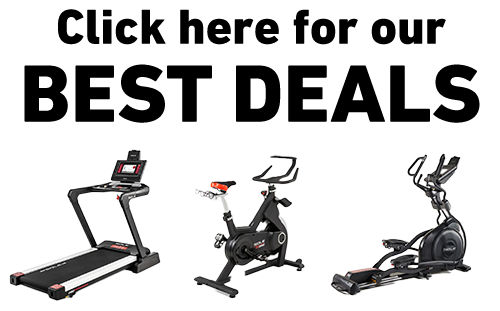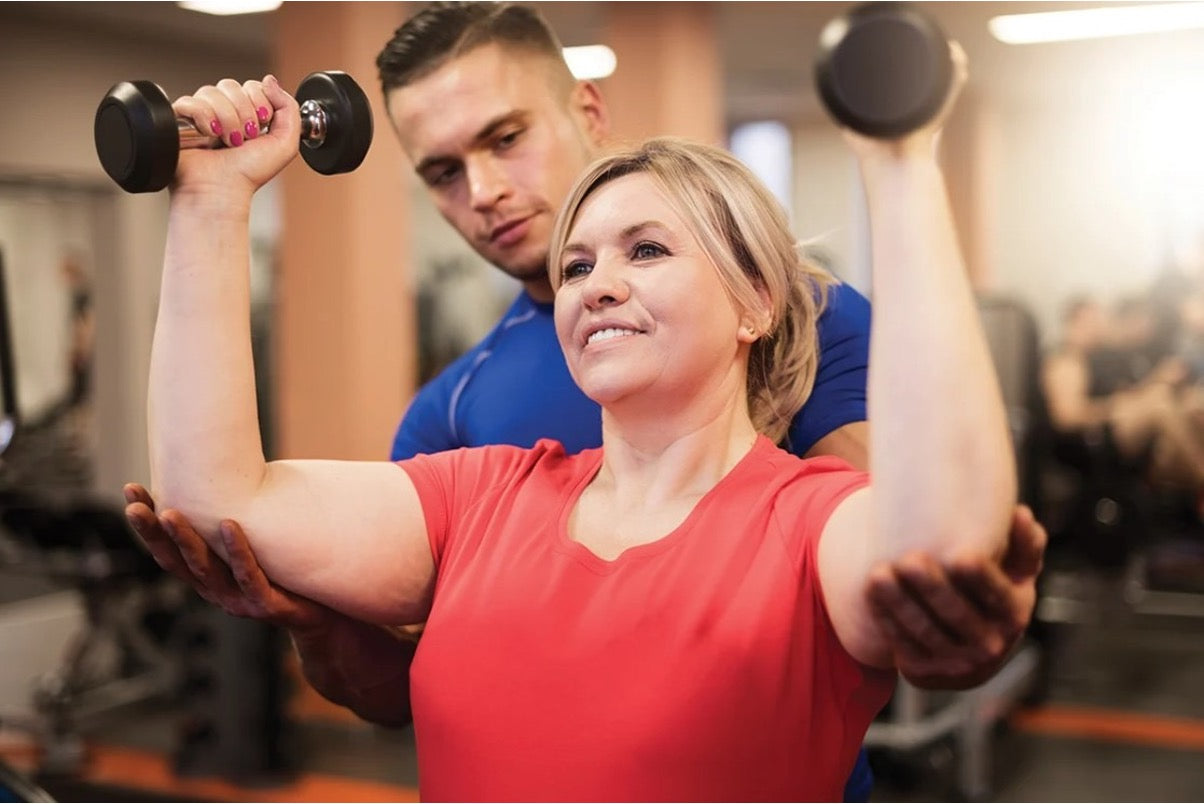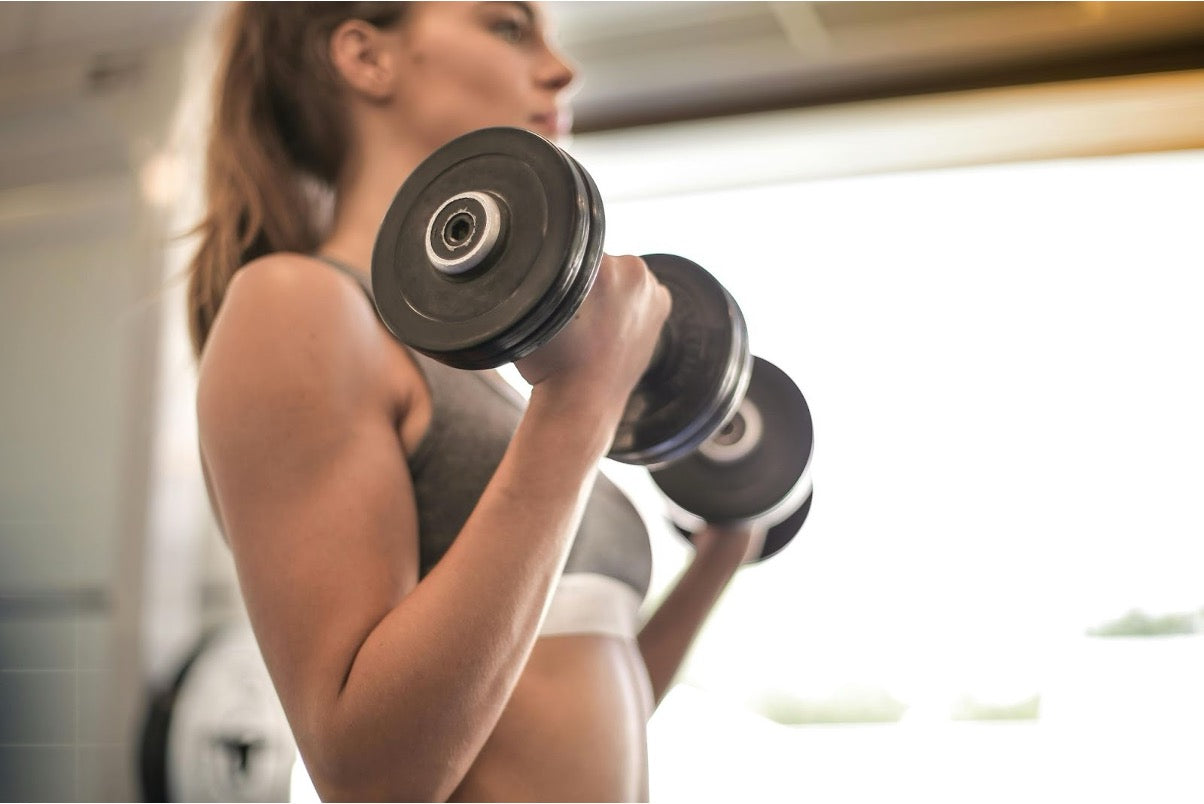Key Takeaways
- The dumbbell shoulder press offers a greater range of motion and unilateral development compared to the barbell overhead press, making it excellent for addressing muscle imbalances.
- Barbell overhead presses allow for heavier loading potential, which may lead to greater strength gains in the deltoids, triceps, and upper chest.
- While many use the terms interchangeably, overhead press typically refers to barbell movements while shoulder press encompasses various equipment options including dumbbells.
- Both exercises primarily target the anterior deltoid, but engage supporting muscles differently due to their unique stability requirements.
- SOLE's SW180 Adjustable Dumbbells and SW111 Olympic Barbell provide the complete solution for incorporating both pressing variations into your training program for optimal shoulder development.
Shoulder Press vs Overhead Press: What's the Real Difference?
Confused about whether to grab dumbbells or load up a barbell for your shoulder training? You're not alone. The dumbbell shoulder press and barbell overhead press are cornerstone exercises for building impressive shoulder strength and size, but understanding their differences is crucial for optimal results.
These two pressing variations impact muscle activation, strength development, and even injury risk. While often used interchangeably in gym conversations, these exercises have distinct characteristics that make each valuable for different training goals.
The first point of confusion comes down to terminology. In fitness circles, "overhead press" typically refers to the barbell version performed from a standing position, also known as the military press.
The term "shoulder press" is broader, encompassing any movement where weight is pressed vertically overhead, regardless of the equipment used: dumbbells, machines, kettlebells, or barbells.
From a biomechanical perspective, the key difference lies in the movement pattern and stability demands. With a barbell overhead press, both arms work symmetrically to lift a single implement, requiring coordinated bilateral strength. Your body must maintain perfect balance as the bar travels along a fixed vertical path.
Dumbbell shoulder presses, by contrast, allow each arm to move independently along its own natural path. This independence creates greater freedom of movement but demands more stabilization from smaller supporting muscles. Your shoulders, particularly the rotator cuff muscles, work harder to control the separate weights through their full range of motion.
The equipment difference also impacts your grip orientation. Barbell presses typically use a pronated (palms forward) grip with fixed hand positioning.
Dumbbell presses offer flexibility with neutral (palms facing each other), pronated, or even supinated (palms backward) grip options, allowing you to find the most comfortable position for your shoulder anatomy.
|
Build Your Foundation with Premium-Grade Strength Equipment!
 Complete Your Home Gym:
Why Choose SOLE Strength: ✓ Heavy-duty steel construction with rust protection 30-Day Money-Back Guarantee: Love it or return it, no questions asked. |
Dumbbell Shoulder Press: Form, Technique, and Execution

The dumbbell shoulder press stands out for its versatility and joint-friendly nature, offering grip customization and enhanced range of motion compared to barbell alternatives.
Begin by selecting an appropriate weight—heavy enough for challenge but light enough to maintain perfect form. Position yourself either seated (preferably on a bench with back support) or standing with feet shoulder-width apart for stability.
Clean the dumbbells to shoulder height, positioning them just outside shoulder width with elbows bent at approximately 90 degrees.
Your starting position should have the dumbbells at shoulder level with palms either facing forward (traditional) or facing each other (neutral grip). The neutral grip often feels more comfortable for those with shoulder issues as it places less stress on the anterior shoulder.
From this position, press the weights upward in a controlled motion until your arms are fully extended overhead, without locking out your elbows completely.
Throughout the movement, keep your core engaged, chest up, and avoid excessive arching in your lower back. Lower the weights slowly back to the starting position, controlling the eccentric (lowering) phase for maximum muscle tension.
Proper Hand Position and Grip Options
One of the greatest advantages of dumbbell work is grip customization. The neutral grip (palms facing each other) places your shoulders in a more natural position and can reduce impingement risk for those with shoulder issues.
The traditional pronated grip (palms forward) creates greater anterior deltoid activation but may increase stress on the shoulder joint. Some advanced lifters even experiment with a supinated grip (palms backward) to emphasize the front delts, though this requires significant shoulder mobility.
Range of Motion Advantages
Dumbbells shine in their range of motion (ROM). Unlike a barbell, which restricts movement to a fixed path, dumbbells allow your shoulders to move through their natural arc of motion.
This freedom lets you achieve a deeper stretch at the bottom position and a more complete contraction at the top.
The enhanced ROM translates directly to greater muscle fiber recruitment and potential hypertrophy gains.
Additionally, the independent movement of each arm prevents your dominant side from compensating for weaknesses, ensuring balanced development across both shoulders.
Common Form Mistakes to Avoid
Even with their advantages, dumbbell shoulder presses come with potential pitfalls. The most common form error is excessive lumbar arching, where lifters push their chest forward and curve their lower back to generate momentum.
This compromises core stability and places unnecessary stress on the spine. Maintain a neutral spine position by engaging your core throughout the movement.
Another frequent mistake is flaring the elbows too wide, which can lead to shoulder impingement. Track your elbows at approximately a 45-degree angle relative to your torso, not directly to the sides.
This position optimizes deltoid engagement while minimizing rotator cuff strain.
Barbell Overhead Press: Mastering the Military Press

The barbell overhead press is a classic strength-building movement that enables greater absolute loading through bilateral force production and fixed bar path efficiency.
This compound exercise begins with the barbell positioned at the front of your shoulders, either taken from a rack or cleaned from the floor. Standing with feet shoulder-width apart and core braced, grip the bar with hands slightly wider than shoulder-width.
Initiate the movement by tucking your chin slightly to allow the bar to clear your face as you press it vertically. The ideal bar path travels close to your face, requiring slight head movement backward as the bar passes your nose and forehead.
Once the bar clears your head, push your head slightly "through the window" created by your arms and lock out the weight overhead with shoulders engaged and arms fully extended.
Correct Bar Path and Body Positioning
The optimal bar path for an overhead press follows what strength coaches call the "S curve." The bar starts at the shoulders, moves slightly backward around your face, then returns to a position directly over the midfoot at lockout.
This path allows for the most efficient leveraging of the shoulders and triceps while maintaining balance under the weight.
Body positioning is equally critical for safety and performance. Maintain a neutral spine rather than hyperextending your lower back—a mistake that places tremendous stress on your lumbar vertebrae.
Your stance should be narrow enough for stability but wide enough to allow your hips to assist with drive when handling heavier weights.
Standing vs Seated Variations
The traditional overhead press is performed standing, which engages more total-body musculature and develops greater functional strength. Standing variations require significant core stability and allow for some hip involvement to handle heavier loads.
This full-body integration makes the standing overhead press an excellent choice for developing overall strength and power.
Seated variations, by contrast, eliminate the lower body contribution and isolate the shoulder muscles more directly. This makes the seated overhead press valuable for hypertrophy-focused training or for lifters rehabilitating lower body injuries.
The bench support also reduces the core stability requirement, allowing greater focus on upper body mechanics.
Muscles Targeted: A Complete Breakdown

Both pressing variations primarily target the deltoid muscle group, but they engage supporting muscles differently based on their unique stability demands and movement patterns.
Primary Movers in Both Exercises
In both the dumbbell shoulder press and barbell overhead press, the anterior deltoid serves as the primary mover, generating most of the force required to drive the weight upward. The triceps contribute significantly as elbow extensors, particularly in the lockout portion of the movement.
The upper chest fibers engage during the initial press, especially when using a wider grip on the barbell variation.
The degree of primary muscle activation remains similar between the two exercises. However, the barbell variation typically allows for heavier loading, potentially creating greater absolute tension in these primary movers.
Secondary and Stabilizer Muscles
The secondary and stabilizing musculature is where these exercises begin to differentiate more significantly.
With dumbbell shoulder presses, the medial deltoids work harder to prevent the weights from drifting outward, creating greater lateral head engagement compared to the barbell alternative.
The rotator cuff muscles—supraspinatus, infraspinatus, teres minor, and subscapularis—fire continuously during dumbbell work to maintain proper shoulder joint positioning.
The barbell overhead press, while less demanding on these smaller stabilizers, recruits more full-body musculature. Your trapezius, serratus anterior, and even the rhomboids engage to stabilize the shoulder blades against the heavy load.
Core muscles including the rectus abdominis, transverse abdominis, and erector spinae work isometrically to maintain spinal position.
Hypertrophy Advantages: Maximum Shoulder Growth
The barbell overhead press allows for heavier loading, creating the mechanical tension necessary for myofibrillar hypertrophy—the increase in contractile proteins that contribute to both size and strength.
The stable pressing path also lets you focus on moving maximum weight rather than stabilization.
Dumbbell shoulder presses, while typically performed with lighter weights, create greater time under tension and often allow for a more complete range of motion.
This combination can stimulate sarcoplasmic hypertrophy; the increase in non-contractile elements and fluid within the muscle that contributes significantly to size increases.
Time Under Tension Differences
"Time under tension" (TUT) refers to how long your muscles work during each set, a factor that significantly influences hypertrophy outcomes.
Dumbbell shoulder presses typically create longer TUT compared to barbell overhead presses due to the slower, more controlled nature of the movement. The increased stabilization demands force you to move more deliberately.
This extended tension time can be particularly effective for triggering metabolic stress, which is a key pathway for muscle growth characterized by the accumulation of metabolites like lactate within the working muscles.
How to Program Both Exercises in Your Routine
Optimal Sets, Reps, and Rest Periods
For strength-focused barbell overhead pressing, 3–5 sets of 3–6 repetitions with 2–3 minutes of rest between sets typically produces optimal results. This lower rep range with heavier loading creates the mechanical tension and neural drive necessary for maximal strength development.
Dumbbell shoulder presses generally work best in the moderate-to-high repetition ranges, with 3–4 sets of 8–12 repetitions and 60–90 seconds of rest between sets. This combination creates significant metabolic stress and time under tension while allowing sufficient loading for mechanical tension.
Master Both Shoulder Press Variations with SOLE

SOLE's comprehensive strength equipment—featuring adjustable dumbbells, Olympic barbell, and versatile weight bench provides everything needed for complete shoulder development.
SOLE's SW180 Adjustable Dumbbells provide the foundation for progressive dumbbell shoulder press training.
With 16 weight options from 5–80 pounds, you can start with lighter weights to perfect neutral-grip and pronated-grip techniques, then systematically increase load as your pressing strength develops.
The quick-adjust dial system makes weight changes seamless between sets and exercises, crucial for shoulder training that combines pressing with isolation work.
The SW111 Olympic Barbell is essential for barbell overhead press training, delivering the professional-grade equipment needed for building maximum pressing strength.
The precision-engineered 7-foot Olympic standard construction features chrome grooved sleeves for secure plate loading, heavy-duty steel with rust protection, and strategically placed knurling that provides excellent grip without tearing up your hands during high-volume pressing sessions.
The SW116 Weight Bench transforms your pressing capabilities by providing rock-solid support for seated dumbbell presses, eliminating core fatigue that can limit shoulder work.
The 9 adjustable positions allow you to perform incline presses, decline variations, and various shoulder isolation exercises that complement your main pressing work. The commercial-grade construction handles heavy dumbbell work safely while the ergonomic design ensures proper positioning throughout your range of motion.
The SOLE Equipment Mat provides essential stability for standing press variations, while its generous size accommodates all setup positions for both dumbbell and barbell work. The superior grip prevents slipping during heavy overhead pressing, while the easy-clean material handles intense training sessions.
The SOLE+ App includes structured shoulder training programs that systematically progress through both pressing variations with optimal rep schemes, load prescriptions, and periodization strategies.
Frequently Asked Questions (FAQs)
Can beginners safely perform overhead presses?
Yes, beginners can safely perform overhead presses with appropriate progression and technique coaching. Start with lighter dumbbells to master the basic movement pattern and develop the requisite shoulder stability before advancing to barbell variations. Focus initially on perfect technique rather than load, ensuring you can achieve a full overhead position without compensating through the lower back.
Do I need to do both exercises in my workout routine?
While not absolutely necessary, incorporating both dumbbell and barbell pressing variations into your program provides complementary benefits that maximize long-term development. The barbell overhead press builds raw pressing strength and power, while dumbbell work enhances stability, range of motion, and balanced development.
Which press is better for shoulder width and definition?
Dumbbell shoulder presses typically create greater lateral deltoid activation, making them slightly more effective for developing the shoulder width that creates the coveted V-taper physique. The independent movement paths and increased stabilization requirements engage the medial deltoid fibers more completely compared to barbell variations.
Should I always lock out my arms at the top of these movements?
Full lockout is generally recommended for barbell overhead presses, as it develops important stabilization strength at the completion of the movement and clearly defines successful repetitions. The locked position, with arms fully extended but elbows not hyperextended, teaches proper alignment with the weight directly over the midfoot and shoulders actively supporting the load.
How does SOLE equipment support both dumbbell and barbell shoulder press training?
SOLE provides the complete solution for comprehensive shoulder press training. The SW180 Adjustable Dumbbells offer 16 weight options from 5–80 pounds, perfect for progressive dumbbell shoulder press training with the quick-adjust dial system enabling efficient weight changes between sets. The SW111 Olympic Barbell provides the foundation for barbell overhead press training. The SW116 Weight Bench supports both seated dumbbell presses and provides a stable platform for accessory shoulder work, with 9 adjustable positions for targeting muscles from multiple angles.




Leave a comment
This site is protected by hCaptcha and the hCaptcha Privacy Policy and Terms of Service apply.